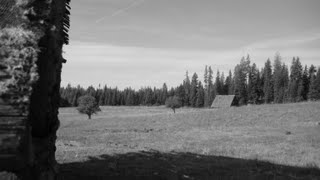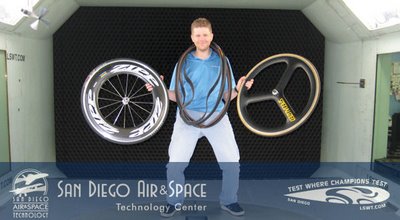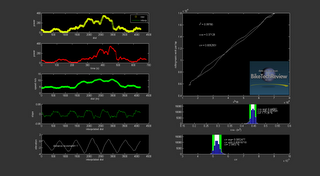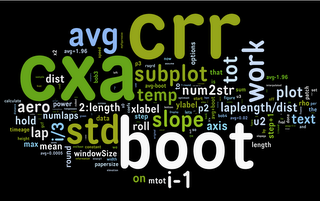Field Testing: on-road rolling resistance
I just got back from a little vacation - it's always nice to catch up with family you haven't seen in a real long time...and that whole vacation thing can sometimes be a bit re-energizing too!
Here's a pretty neat shot I managed to snap of a small cabin in the woods that we were helping to stock up in Northeastern Oregon last week:

Hey, now that I'm all re-energized and whatnot, I decided to take another look (kind of in aggregate) at the data I gathered in this BTR Forum thread:
http://biketechreview.com/forum/viewtopic.php?f=1&t=2552
All in all, thus far, I have managed to do 6 runs at 140 psi and 4 runs at 120 psi on a road that I would characterize as pretty rough. There's a picture of the road surface in the thread linked above, so you can make up your own mind, though.
As it turns out, the 140 psi runs on the road had an average Crr that was ~10% lower than the 120 psi runs.
Interestingly, I also tested the same tires on my smooth aluminum rollers in the garage just after these on-road field tests...and not too surprisingly, the 140 psi run was around 8-10% lower in it's Crr than the 120 psi run.
One might also expect that the on-road Crr values would be higher than the smooth aluminum roller case...and, indeed the on-road values were in the 35% higher ballpark. So, that'd mean that if one was using the Crr values here to estimate things/tradeoffs:
http://www.biketechreview.com/tires/AFM_tire_crr.htm
you might only have to multiply the crr of the tires by 15% or so...more work to be done on this topic, though, eh?
These preliminary results are encouraging to me, in that things seem to be consistent (trend-wise). It's good to pursue multiple, independent, lines of inquiry when exploring a topic, eh? But dang, this field testing stuff is pretty tedious and just about as much fun as watching grass grow! :-)
In Summary:
-140 psi was a wee bit faster on average than 120 psi in this comparison
-rough roads seem to have a higher Crr than smooth rollers
-field testing in order to determine Crr is difficult and boring business
Here's a pretty neat shot I managed to snap of a small cabin in the woods that we were helping to stock up in Northeastern Oregon last week:

Hey, now that I'm all re-energized and whatnot, I decided to take another look (kind of in aggregate) at the data I gathered in this BTR Forum thread:
http://biketechreview.com/forum/viewtopic.php?f=1&t=2552
All in all, thus far, I have managed to do 6 runs at 140 psi and 4 runs at 120 psi on a road that I would characterize as pretty rough. There's a picture of the road surface in the thread linked above, so you can make up your own mind, though.
As it turns out, the 140 psi runs on the road had an average Crr that was ~10% lower than the 120 psi runs.
Interestingly, I also tested the same tires on my smooth aluminum rollers in the garage just after these on-road field tests...and not too surprisingly, the 140 psi run was around 8-10% lower in it's Crr than the 120 psi run.
One might also expect that the on-road Crr values would be higher than the smooth aluminum roller case...and, indeed the on-road values were in the 35% higher ballpark. So, that'd mean that if one was using the Crr values here to estimate things/tradeoffs:
http://www.biketechreview.com/tires/AFM_tire_crr.htm
you might only have to multiply the crr of the tires by 15% or so...more work to be done on this topic, though, eh?
These preliminary results are encouraging to me, in that things seem to be consistent (trend-wise). It's good to pursue multiple, independent, lines of inquiry when exploring a topic, eh? But dang, this field testing stuff is pretty tedious and just about as much fun as watching grass grow! :-)
In Summary:
-140 psi was a wee bit faster on average than 120 psi in this comparison
-rough roads seem to have a higher Crr than smooth rollers
-field testing in order to determine Crr is difficult and boring business
Labels: Crr, CxA, field testing, power, powermeter





